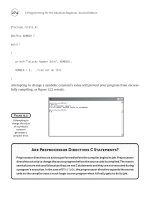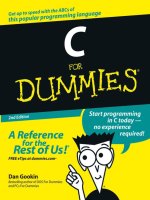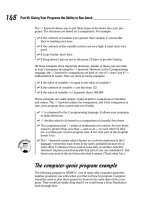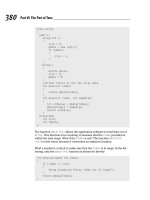C++ for Mathematicians An Introduction for Students and Professionals phần 10 ppt
Bạn đang xem bản rút gọn của tài liệu. Xem và tải ngay bản đầy đủ của tài liệu tại đây (980.2 KB, 52 trang )
Answers 445
6 = 1+1+1+1+1+1
11 partitions of 6
✝ ✆
8.7 The solution is to use a
static look-up table that takes pairs of long values
as keys. To create such a table, be sure to
#include <map> and give the
following declaration.
static map< pair<long,long> , long > table;
Here is a program with a binomial procedure and a main to check that it
works.
#include <map>
#include <iostream>
using namespace std;
long binomial(long n, long k) {
static map< pair<long,long> , long > table;
if (k>n) return 0;
if (k==0) return 1;
if (k==n) return 1;
pair<long, long> args = make_pair(n,k);
if (table.count(args) > 0) {
return table[args];
}
table[args] = binomial(n-1,k-1) + binomial(n-1,k);
return table[args];
}
int main() {
for (int n=0; n<10; n++) {
for (int k=0; k<10; k++) {
cout << binomial(n,k) << "\t";
}
cout << endl;
}
return 0;
}
The code gives Pascal’s triangle as output.
✞
☎
1000000000
1100000000
1210000000
1331000000
1464100000
151010510000
1615201561000
1 7 213535217 1 0 0
1 8 28567056288 1 0
1 9 368412612684369 1
✝ ✆
446 C++ for Mathematicians
8.8 The inputs to the procedure are the array and an integer specifying the length
of the array. The
vector can either be the return value of the procedure or a
reference argument:
vector<long> array2vector(const long
*
list, long nels);
void array2vector(const long
*
list, long nels,
vector<long>& vlist);
The first is, perhaps, more natural, however, the second is more efficient. The
problem with the first approach is that when the
return statement executes,
the
vector<long> built in the procedure is copied to the receiving variable
in the calling procedure.
Here is code for the procedure using the second approach.
#include <vector>
using namespace std;
void array2vector(const long
*
list, long nels,
vector<long>& vlist) {
vlist.resize(nels);
for (int k=0; k<nels; k++) vlist[k] = list[k];
}
8.9 The solution is to use iterators that point to the first and one-past-the-last ele-
ments of the
vector like this,
sort(values.begin(), values.end());
The following code illustrates this approach.
#include <vector>
#include <iostream>
using namespace std;
const int N = 10;
int main() {
vector<long> values;
values.resize(N);
for (int k=0; k<N; k++) {
values[k] = rand()%1000;
cout << values[k] << " ";
}
cout << endl << endl;
sort(values.begin(), values.end());
for (int k=0; k<N; k++) cout << values[k] << " ";
cout << endl;
return 0;
}
Here is the output of this program.
Answers 447
✞
☎
807 249 73 658 930 272 544 878 923 709
73 249 272 544 658 709 807 878 923 930
✝ ✆
8.10 This is dangerous. The iterator is now focused on a part of a set that no longer
exists. Such an action renders the iterator invalid. Even worse, all iterators
referring to the modified set are now invalid.
8.11 It is tempting (but wrong) to write code like this:
set<long>::iterator sp;
for (sp = A.begin(); sp != A.end(); ++sp) {
if (
*
sp%2 == 1) A.erase(
*
sp);
}
The problem, as we discussed in the solution to Exercise 8.10, is that once we
erase the element referred to by an iterator, the iterator beco mes invalid. We
need a different approach.
The technique we illustrate here is to step through the set and place a copy of
the odd elements we find in a container (in the following code we use a stack,
but other choices would work as well). Once we have accumulated copies
of all the odd elements in the set, we run through the stack and delete the
corresponding elements from the set. Here’s the code.
#include <set>
#include <stack>
using namespace std;
void delete_odds(set<long>& A) {
stack<long> eliminate;
set<long>::const_iterator sp;
for (sp=A.begin(); sp!=A.end(); ++sp) {
if (
*
sp % 2 == 1) eliminate.push(
*
sp);
}
while (!eliminate.empty()) {
A.erase(eliminate.top());
eliminate.pop();
}
}
8.12 Here is the code.
#include <set>
#include <algorithm>
#include <iostream>
using namespace std;
void print_element(long x) { cout << x << " "; }
void print_set(set<long>& A) {
cout << "{ ";
for_each(A.begin(), A.end(), print_element);
448 C++ for Mathematicians
cout << "}" << endl;
}
Note that we first define the procedure print_element. This procedure is
used as an argument to
for_each in the print_set procedure.
9.2 Here is a complete solution. First we present the header file
Time.h in which
the short methods are defined inline. The private method
adjust() is used
to correct the variables so they fall in the proper ranges. For example, if
the hour/minute/second variables have values (5,59,65), then adjust would
change these to (6,0,5).
Notice the use of a
static variable ampm_style that is modified via the
static methods ampm() and military().
#ifndef TIME_H
#define TIME_H
#include <iostream>
using namespace std;
class Time {
private:
long hour, min, sec;
static bool ampm_style;
void adjust();
public:
Time() { hour = min = sec = 0; }
Time(int H, int M, int S);
Time operator+(long n) const;
Time operator-(long n) const;
Time operator++();
Time operator ();
int get_hour() const { return hour; }
int get_minute() const { return min; }
int get_second() const { return sec; }
static void ampm() { ampm_style = true; }
static void military() { ampm_style = false; }
static bool is_ampm() { return ampm_style; }
};
Time operator+(long n, const Time& T);
ostream& operator<<(ostream& os, const Time& T);
#endif
Next we give the code file Time.cc.
#include "Time.h"
bool Time::ampm_style = true;
void Time::adjust() {
// adjust the seconds field first
Answers 449
if (sec < 0) {
long change = (-sec)/60 + 1;
sec += change
*
60;
min -= change;
}
if (sec > 59) {
long change = sec/60;
sec -= change
*
60;
min += change;
}
// adjust the min field next
if (min < 0) {
long change = (-min)/60 + 1;
min += change
*
60;
hour -= change;
}
if (min > 59) {
long change = min/60;
min -= change
*
60;
hour += change;
}
// finally, adjust the hour
if (hour < 0) {
long change = (-hour/24) + 1;
hour += change
*
24;
}
if (hour > 23) {
hour %= 24;
}
}
Time::Time(int H, int M, int S) {
hour = H;
min = M;
sec = S;
adjust();
}
Time Time::operator+(long n) const {
Time T =
*
this;
T.sec += n;
T.adjust();
return T;
}
Time operator+(long n, const Time& T) {
return T+n;
}
Time Time::operator-(long n) const {
Time T =
*
this;
T.sec -= n;
T.adjust();
return T;
}
450 C++ for Mathematicians
Time Time::operator++() {
++sec;
adjust();
return
*
this;
}
Time Time::operator () {
sec;
adjust();
return
*
this;
}
ostream& operator<<(ostream& os, const Time& T) {
long h = T.get_hour();
long m = T.get_minute();
long s = T.get_second();
if (Time::is_ampm()) { // am-pm style
if (h==0) {
os << 12;
}
else if (h>12) {
os << h-12;
}
else {
os << h;
}
os << ":";
if (m < 10) os << 0;
os << m;
os << ":";
if (s < 10) os << 0;
os << s;
if (h < 12) {
os << " am";
}
else {
os << " pm";
}
}
else { // military time
os << h << ":";
if (m < 10) os << 0;
os << m << ":";
if (s < 10) os << 0;
os << s ;
}
return os;
}
Finally, the following code shows how to extract the current local time on a
UNIX computer. Unfortunately, it is difficult to understand. Fortunately, it is
unusual for a program that solves a mathematics problem to need to deal with
Answers 451
the current time of day.
#include <ctime>
#include <iostream>
#include "Time.h"
using namespace std;
Time now() {
time_t clock = time(0);
long h = localtime(&clock)->tm_hour;
long m = localtime(&clock)->tm_min;
long s = localtime(&clock)->tm_sec;
return Time(h,m,s);
}
int main() {
cout << "At the tone, the time will be " << now() << endl;
return 0;
}
If you need to deal extensively with date and time matters, it is worth your
while to download, build, and install a package created by someone else. For
example, the Boost C++ package provides classes for working with date and
time. (See Chapter 13 about working with packages you find on the Web
including a brief description of Boost on page 286.)
9.3 Here is the header file
EuclideanVector.h.
#ifndef EUCLIDEAN_VECTOR_H
#define EUCLIDEAN_VECTOR_H
#include <vector>
#include <iostream>
using namespace std;
class EuclideanVector {
private:
static int DEFAULT_DIM;
int dim;
vector<double> coords;
public:
EuclideanVector();
EuclideanVector(int n);
static int get_default_dim() { return DEFAULT_DIM; }
static void set_default_dim(int n);
double get(int n) const;
void set(int n, double x);
int get_dim() const { return dim; }
EuclideanVector operator+(const EuclideanVector& that) const;
EuclideanVector operator
*
(double s) const;
bool operator==(const EuclideanVector& that) const;
bool operator!=(const EuclideanVector& that) const;
};
452 C++ for Mathematicians
EuclideanVector operator
*
(double s, const EuclideanVector& v);
ostream& operator<<(ostream& os, const EuclideanVector& v);
#endif
Here is the code file EuclideanVector.cc.
#include "EuclideanVector.h"
int EuclideanVector::DEFAULT_DIM = 2;
EuclideanVector::EuclideanVector() {
dim = DEFAULT_DIM;
coords.resize(dim);
for (int k=0; k<dim; k++) coords[k] = 0.;
}
EuclideanVector::EuclideanVector(int n) {
if (n < 0) {
cerr << "Cannot construct vector with negative dimension"
<< endl << "using zero instead" << endl;
n=0;
}
dim = n;
coords.resize(n);
for (int k=0; k<dim; k++) coords[k] = 0.;
}
void EuclideanVector::set_default_dim(int n) {
if (n < 0) {
cerr << "Cannot set default dimension to be negative"
<< endl << "using zero instead" << endl;
n=0;
}
DEFAULT_DIM = n;
}
double EuclideanVector::get(int n) const {
n %= dim;
if (n < 0) n += dim;
return coords[n];
}
void EuclideanVector::set(int n, double x) {
n%=dim;
if (n < 0) n += dim;
coords[n] = x;
}
EuclideanVector
EuclideanVector::operator+(const EuclideanVector& that) const {
if (dim != that.dim) {
cerr << "Attempt to add vectors of different dimensions"
<< endl;
return EuclideanVector(0);
}
EuclideanVector ans(dim);
Answers 453
for (int k=0; k<dim; k++) {
ans.coords[k] = coords[k] + that.coords[k];
}
return ans;
}
EuclideanVector
EuclideanVector::operator
*
(double s) const {
EuclideanVector ans(dim);
for (int k=0; k<dim; k++) ans.coords[k] = s
*
coords[k];
return ans;
}
bool
EuclideanVector::operator==(const EuclideanVector& that) const {
if (dim != that.dim) return false;
for (int k=0; k<dim; k++) {
if (coords[k] != that.coords[k]) return false;
}
return true;
}
bool
EuclideanVector::operator!=(const EuclideanVector& that) const {
return !( (
*
this) == that );
}
EuclideanVector operator
*
(double s, const EuclideanVector& v) {
return v
*
s;
}
ostream& operator<<(ostream& os, const EuclideanVector& v) {
os << "[ ";
for (int k=0; k<v.get_dim(); k++) os << v.get(k) << " ";
os << "]";
return os;
}
9.4 Here are the files S.h and S.cc that implement the set S and its operation ∗.
#ifndef S_H
#define S_H
#include <iostream>
#include <cmath>
using namespace std;
class S {
private:
long n;
public:
S(){n=0;}
S(long a) {
if (a<0) a = -a;
n=a;
}
long getN() const { return n; }
454 C++ for Mathematicians
double value() const { return sqrt(n); }
S operator
*
(const S& that) const { return S(n + that.n); }
};
ostream& operator<<(ostream& os, const S& s);
#endif
#include "S.h"
ostream& operator<<(ostream& os, const S& s) {
os << "sqrt(" << s.getN() << ")";
return os;
}
9.5 See the file quaternions.h on the CD-ROM that accompanies this book.
This file includes embedded Doxygen comments and the CD-ROM includes
the Web pages they generate.
10.1 The two classes are defined in the following
.h file. There is no need for a
.cc file.
#ifndef _RECTANGLE_
#define _RECTANGLE_
class Rectangle {
protected:
double h,w; // hold the height and width
public:
Rectangle(double x=1.0, double y=1.0) {
h=x;
w=y;
}
double get_width() const { return w; }
double get_height() const { return h; }
void set_width(double x) { w = x; }
void set_height(double y) { h = y; }
double area() const { return h
*
w; }
double perimeter() const { return 2.
*
(h+w); }
};
class Square : public Rectangle {
public:
Square(double s = 1.) : Rectangle(s,s) { }
void set_width(double x) { w = x; h = x; }
void set_height(double y) { w = y; h = y; }
};
Answers 455
#endif
10.2 Here is a file parallelogram.h that defines all three classes.
#ifndef PARALLELOGRAM_H
#define PARALLELOGRAM_H
#include <cmath>
class Parallelogram {
protected:
double a,b,c;
public:
Parallelogram() { a = b = c = 0.; }
Parallelogram(double x1, double x2, double y2) {
if (x1 < 0) x1 = -x1;
if (y2 < 0) y2 = -y2;
a=x1;
b=x2;
c=y2;
}
double area() const { return c
*
a; }
double perimeter() const {
return 2
*
sqrt(b
*
b+c
*
c) + 2
*
a;
}
};
class Rectangle : public Parallelogram {
public:
Rectangle(double height, double width) :
Parallelogram(width, 0., height) {}
double perimeter() const { return 2
*
a+2
*
c; }
};
class Rhombus : public Parallelogram {
public:
Rhombus(double x, double y) :
Parallelogram(sqrt(x
*
x)+sqrt(y
*
y),x,y){}
double perimeter() const { return 4
*
a; }
};
#endif
10.3 The class mycomplex can be defined in a header file, mycomplex.h, like this.
#ifndef MY_COMPLEX_H
#define MY_COMPLEX_H
#include <complex>
using namespace std;
class mycomplex : public complex<double> {
public:
mycomplex() : complex<double> (0.,0.) {}
mycomplex(double r) : complex<double> (r,0.) {}
mycomplex(double r, double i) : complex<double> (r,i) {}
456 C++ for Mathematicians
bool operator<(const mycomplex& that) const {
if (real() < that.real()) return true;
if (real() > that.real()) return false;
if (imag() < that.imag()) return true;
return false;
}
};
#endif
We define the three constructors by passing arguments up to the constructor
for
complex<double>. No further action is required by these constructors
and so the bodies of these three constructors are empty:
{}.
Next the operator
< is defined. Note that we use the complex<double> meth-
ods
real() and imag() to access the data, and then use lexicographic order-
ing.
Here is a short main to test the
mycomplex class.
#include "mycomplex.h"
#include <iostream>
#include <set>
using namespace std;
int main() {
mycomplex z;
mycomplex w(2);
mycomplex v(-5,2);
set<mycomplex> S;
S.insert(z);
S.insert(w);
S.insert(v);
set<mycomplex>::iterator si;
for (si = S.begin(); si != S.end(); ++si) {
cout <<
*
si << " ";
}
cout << endl;
return 0;
}
This produces the following output.
✞
☎
(-5,2) (0,0) (2,0)
✝ ✆
10.4 The difficulty here is that each class depends on the other, leaving us in a
quandary as to which to define first. In C++ one must declare classes and
variables before they can be used. So, the solution is to give a preliminary
declaration of the
Segment class before giving a full declaration of Point.
This is done with the statement
class Segment; in the header file.
Answers 457
The
operator+ in Point uses the Segment(Point,Point) constructor
to convert a pair of points into a line segment. We cannot put the code for
operator+ inline in the declaration of the Point class because the required
Segment(double,double) constructor has not yet been declared. So we
are compelled to write the code for
operator+ in a separate .cc file.
Here are the files
pointseg.h and pointseg.cc.
#ifndef POINTSEG_H
#define POINTSEG_H
#include <iostream>
using namespace std;
class Segment;
class Point {
private:
double x,y;
public:
Point(){x=y=0;}
Point(double xx, double yy) {
x=xx;
y=yy;
}
double getX() const { return x; }
double getY() const { return y; }
Segment operator+(const Point& that) const;
};
class Segment {
private:
Point A,B;
public:
Segment() { A = Point(0,0); B = Point(1,0); }
Segment(Point X, Point Y) { A = X; B = Y; }
Point getA() const { return A; }
Point getB() const { return B; }
Point midpoint() const;
};
ostream& operator<<(ostream& os, const Point& P);
ostream& operator<<(ostream& os, const Segment& S);
#endif
#include "pointseg.h"
Segment Point::operator+(const Point& that) const {
return Segment(
*
this, that);
}
Point Segment::midpoint() const {
double x = (A.getX() + B.getX()) / 2;
double y = (A.getY() + B.getY()) / 2;
return Point(x,y);
458 C++ for Mathematicians
}
ostream& operator<<(ostream& os, const Point& P) {
os << "(" << P.getX() << "," << P.getY() << ")";
return os;
}
ostream& operator<<(ostream& os, const Segment& S) {
os << "[" << S.getA() << "," << S.getB() << "]";
return os;
}
10.5 No. Suppose that class Alpha declares a data member of type Beta and vice
versa. If this were allowed, we could create an infinite nesting:
Alpha objects
contain
Beta objects which in turn contain Alpha objects, ad infinitum.
Examine this header file and the problem should become clear.
class Beta;
class Alpha {
private:
Beta b;
};
class Beta {
private:
Alpha a;
};
Trying to #include this header file into a program generates a compiler error
message like this.
✞
☎
In file included from alphabeta.cc:1:
alphabeta.h:5: error: field ‘b’ has incomplete type
✝ ✆
10.6 The key idea is to derive
Complexx as a subclass of complex<double> and
add two Boolean data fields to signal whether the object is infinite and whether
the object is invalid. To save some typing, we
typedef the symbol C to be
shorthand for
complex<double>.
To define the arithmetic operators, we rely on the corresponding operators
from
complex. To convert an object z of type Complexx to its parent class C,
we use the expression
C(z). So, to multiple Complexx objects w and z,we
first check for special cases where either is infinite or invalid, and then to get
the required product we may use the expression
C(w)
*
C(z).
Here are the files
Complexx.h and Complexx.cc.Tomakethisclassmore
useful, we should add the operators
+=, -=,
*
=
,and/=. We should also extend
all the arithmetic operators so that one of the arguments can be a
double.
#include <complex>
using namespace std;
Answers 459
typedef double R;
typedef complex<R> C;
class Complexx : public C {
private:
bool infinite;
bool invalid;
public:
Complexx(C z) : C(z) {
infinite = false;
invalid = false;
}
Complexx(R a, R b) : C(a,b) {
infinite = false;
invalid = false;
}
bool isZero() const {
return !invalid && !infinite && C(
*
this) == C(0);
}
bool isInfinite() const {
return !invalid && infinite;
}
bool isInvalid() const { return invalid; }
bool operator==(const Complexx& that) const {
if (invalid || that.invalid) return false;
if (infinite && that.infinite) return true;
return C(
*
this) == C(that);
}
bool operator!=(const Complexx& that) const {
if (invalid || that.invalid) return false;
return !(
*
this == that);
}
Complexx operator+(const Complexx& that) const;
Complexx operator-() const;
Complexx operator-(const Complexx& that) const;
Complexx operator
*
(const Complexx& that) const;
Complexx operator/(const Complexx& that) const;
};
ostream& operator<<(ostream& os, const Complexx& z);
#include "Complexx.h"
Complexx Complexx::operator+(const Complexx& that) const {
Complexx ans(C(
*
this) + C(that));
if (invalid || that.invalid) {
ans.invalid = true;
return ans;
}
if (infinite && that.infinite) {
ans.invalid = true;
460 C++ for Mathematicians
return ans;
}
if (infinite || that.infinite) {
ans.infinite = true;
return ans;
}
return ans;
}
Complexx Complexx::operator-() const {
Complexx ans(-C(
*
this));
if (invalid) {
ans.invalid = true;
return ans;
}
if (infinite) {
ans.infinite = true;
return ans;
}
return ans;
}
Complexx Complexx::operator-(const Complexx& that) const {
return (
*
this) + (-that);
}
Complexx Complexx::operator
*
(const Complexx& that) const {
Complexx ans(C(
*
this)
*
C(that));
if (invalid || that.invalid) {
ans.invalid = true;
return ans;
}
if (infinite && that.isZero()) {
ans.invalid = true;
return ans;
}
if (isZero() && that.infinite) {
ans.invalid = true;
return ans;
}
if (infinite || that.infinite) {
ans.infinite = true;
return ans;
}
return ans;
}
Complexx Complexx::operator/(const Complexx& that) const {
Complexx ans(C(
*
this) / C(that));
if (invalid || that.invalid) {
ans.invalid = true;
return ans;
}
if (isZero() && that.isZero()) {
ans.invalid = true;
return ans;
Answers 461
}
if (infinite && that.infinite) {
ans.invalid = true;
return ans;
}
if (infinite) {
ans.infinite = true;
return ans;
}
if (that.infinite) {
ans = Complexx(0.,0.);
return ans;
}
if (that.isZero()) {
ans.infinite = true;
return ans;
}
return ans;
}
ostream& operator<<(ostream& os, const Complexx& z) {
if (z.isInvalid()) {
os << "INVALID";
return os;
}
if (z.isInfinite()) {
os << "Infinity";
return os;
}
os << C(z);
return os;
}
11.1 Here is a hint. Suppose that
π
is written in disjoint cycle notation. The order
of
π
is the least common multiple of lengths of the cycles. Also f or positive
integers a and b, the least common multiple of a and b is ab/ gcd(a,b).
11.2 Here is the file
Counted.h. Notice how we use the constructor just to incre-
ment the variable
n_objects and the destructor to decrement it.
#ifndef COUNTED_H
#define COUNTED_H
class Counted {
private:
static long n_objects;
public:
Counted() { n_objects++; }
˜Counted() { n_objects ; }
long static count() { return n_objects; }
};
#endif
462 C++ for Mathematicians
This header file contains nearly everything except the code to initialize the
static class variable n_objects. This is done in a separate source file,
Counted.cc:
#include "Counted.h"
long Counted::n_objects = 0;
11.3 Here are the files Partition.h and Partition.cc.
#ifndef PARTITION_H
#define PARTITION_H
#include <iostream>
using namespace std;
class Partition {
private:
int sum;
int n_parts;
int
*
parts;
public:
Partition() {
sum = n_parts = 0;
parts = new int[1];
}
Partition(const Partition& that) {
sum = that.sum;
n_parts = that.n_parts;
parts = new int[n_parts+1];
for (int k=0; k<n_parts; k++) parts[k] = that.parts[k];
}
˜Partition() {
delete[] parts;
}
Partition operator=(const Partition& that) {
sum = that.sum;
n_parts = that.n_parts;
delete[] parts;
parts = new int[n_parts+1];
for (int k=0; k<n_parts; k++) parts[k] = that.parts[k];
return
*
this;
}
void add_part(int n);
int get_sum() const { return sum; }
int nparts() const { return n_parts; }
int operator[](int k) const;
bool operator<(const Partition& that) const;
};
ostream& operator<<(ostream& os, const Partition& P);
#endif
#include "Partition.h"
void Partition::add_part(int n) {
Answers 463
if (n <= 0) {
cerr << "Cannot add a negative part" << endl;
return;
}
sum+=n;
int
*
new_parts = new int[n_parts+1];
for (int k=0; k<n_parts; k++) {
new_parts[k] = parts[k];
}
new_parts[n_parts] = n;
n_parts++;
sort(new_parts, new_parts+n_parts);
delete[] parts;
parts = new_parts;
}
int Partition::operator[](int k) const {
if ((k<0) || (k>=n_parts)) {
cerr << "Index out of range" << endl;
return -1;
}
return parts[k];
}
bool Partition::operator<(const Partition& that) const {
if (sum < that.sum) return true;
if (sum > that.sum) return false;
if (n_parts < that.n_parts) return true;
if (n_parts > that.n_parts) return false;
for (int k=0; k<n_parts; k++) {
if (parts[k] < that.parts[k]) return true;
if (parts[k] > that.parts[k]) return false;
}
return false;
}
ostream& operator<<(ostream& os, const Partition& P) {
if (P.nparts() < 2) {
os << P.get_sum();
return os;
}
for (int k=0; k<P.nparts(); k++) {
os << P[k];
if (k < P.nparts()-1) os << "+";
}
return os;
}
11.5 Here is the file SmartArray.h that implements the class.
#ifndef SMART_ARRAY_H
#define SMART_ARRAY_H
class SmartArray {
private:
long N;
464 C++ for Mathematicians
long
*
data;
long adjust_index(long k) {
k%=N;
if (k<0) k += N;
return k;
}
public:
SmartArray(long nels = 1) {
N=(nels>1)?nels:1;
data = new long[N];
}
˜SmartArray() { delete[] data; }
long get_N() const { return N; }
long& operator[](long k) {
long kk = adjust_index(k);
return data[kk];
}
};
#endif
Note that we define two private data elements: N (the size of the array) and
data (a place to hold the data elements).
We also d efine a private method
adjust_index that maps an array index to
fall be tween
0 and N-1 (inclusive).
The constructor, after ensuring that its argument is at least 1, allocates storage
for the
data array. The destructor’s only job is to release the memory held by
data.Theget_N method is a convenient way to learn the size of the array.
(Note: In this implementation we do not provide any way to r esize an array.)
And n ow we come to the main point of this exercise: the
operator[] method.
Notice that we declared the return type of this method to be
long&.Ifwehad,
instead, declared the return type to be
long,thenreturn data[kk]; would
simply return a copy of the value held in slot
kk of the data. This is just like
call by value, but in this case, it’s return by value.
By declaring the return type to be
long&, we switch from returning a copy of
a value to returning the actual item itself; that is, we have implemented return
by reference.
Suppose the following statements appear in a
main(),
SmartArray X(10);
X[-1] = 4;
The first declares X to be a SmartArray housing 10 values. When the second
statement is encountered, here’s what happens. First
adjust_index(-1)
runs and returns the value 9 (and that’s held in the temporary variable kk).
Next the code executes
return data[-1];. So the statement X[-1] = 4;
is, effectively, transformed into X.data[9] = 4;.
Answers 465
11.6 The following code is a file named
LFT.h that de fines the class LFT.No-
ticethatwedefined
C to be an abbreviation for complex<double>.We
include get methods to extract the coefficients of the transformation and an
operator<< to print the transformations to the screen.
#ifndef LFT_H
#define LFT_H
#include <complex>
#include <iostream>
using namespace std;
typedef complex<double> C;
class LFT {
private:
C a,b,c,d;
public:
LFT(Caa,Cbb,Ccc,Cdd){
a=aa;b=bb;c=cc;d=dd;
}
LFT() {
a=1;b=0;c=0;d=1;
}
C getA() const { return a; }
C getB() const { return b; }
C getC() const { return c; }
C getD() const { return d; }
C operator()(C z) const {
return (a
*
z+b)/(c
*
z+d);
}
LFT operator
*
(const LFT& T) const {
C aa,bb,cc,dd;
aa = a
*
T.a + b
*
T.c;
bb = a
*
T.b + b
*
T.d;
cc = c
*
T.a + d
*
T.c;
dd = c
*
T.b + d
*
T.d;
return LFT(aa,bb,cc,dd);
}
};
inline ostream& operator<<(ostream& os, const LFT& T) {
os << "z | > (" << T.getA() << "
*
z+"<<T.getB()
<< ")/(" << T.getC() << "
*
z+"<<T.getD()
<< ")";
return os;
}
#endif
11.7 The files Path.h and Path.cc follow. Note that we used a vector container
to house the points. This is easier than managing a
Path
*
array. As a bonus,
because we do not need to
delete[] any arrays we allocated, we do not need
a
˜Path() destructor.
Also note that we did not define an
operator+ for the case Path+Point.
The C++ compiler knows how to convert a
Point to a Path (thanks to the
466 C++ for Mathematicians
single-argument constructor). However, a separate
Point+Path procedure is
necessary.
#ifndef PATH_H
#define PATH_H
#include "Point.h"
#include <vector>
class Path {
private:
vector<Point> pts;
long npts;
public:
Path() { npts = 0; }
Path(const Point& P) {
npts = 1;
pts.resize(1);
pts[0] = P;
}
long size() const { return npts; }
Path operator+(const Path& that) const;
Point operator[](int k) const;
};
Path operator+(const Point& X, const Path& P);
ostream& operator<<(ostream& os, const Path& P);
#endif
#include "Path.h"
Path Path::operator+(const Path& that) const {
Path ans;
ans.npts = npts + that.npts;
ans.pts.resize(ans.npts);
for (int k=0; k<npts; k++) ans.pts[k] = pts[k];
for (int k=0; k<that.npts; k++) ans.pts[k+npts] = that.pts[k];
return ans;
}
Point Path::operator[](int k) const {
if (npts==0) return Point(0,0);
k %= npts;
if (k<0) k = -k;
return pts[k];
}
Path operator+(const Point& X, const Path& P) {
return Path(X) + P;
}
ostream& operator<<(ostream& os, const Path& P) {
os << "[ ";
for (int k=0; k<P.size(); k++) os << P[k] << " ";
Answers 467
os << "]";
return os;
}
12.1 The code is a mildly edited version of the answer to Exercise 7.3; it works for
any type for which the
< is defined. Here is the file median.h.
#ifndef MEDIAN_H
#define MEDIAN_H
#include <algorithm>
using namespace std;
template <class T>
T median(const T
*
array, long nels) {
if (nels < 0) return 0.;
if (nels == 0) return array[0];
T
*
copy_array;
copy_array = new T[nels];
for (int k=0; k<nels; k++) copy_array[k] = array[k];
sort(copy_array, copy_array+nels);
T ans;
ans = copy_array[nels/2];
delete[] copy_array;
return ans;
}
#endif
There is an interesting difference between the algorithm we use here and the
algorithm used in our solution to Exercise 7.3. In the first version, if the array
contains an even number of elements, we return the average to the two central
values. However, this new version might be applied to a type for which addi-
tion and division by 2 is not defined. Our solution is to return element number
n/2 of (the sorted copy of) an array with n elements.
12.2 Here is the new version of
SmartArray.h.
#ifndef SMART_ARRAY_H
#define SMART_ARRAY_H
template <class T>
class SmartArray {
private:
long N;
T
*
data;
long adjust_index(long k) {
k%=N;
if (k<0) k += N;
return k;
}
public:
SmartArray(long nels = 1) {
468 C++ for Mathematicians
N=(nels>1)?nels:1;
data = new T[N];
}
˜SmartArray() { delete[] data; }
long get_N() const { return N; }
T& operator[](long k) {
long kk = adjust_index(k);
return data[kk];
}
};
#endif
12.3 Here is a file derivative.h that creates a template procedure derivative.
#ifndef DERIVATIVE_H
#define DERIVATIVE_H
#include "Polynomial.h"
template <class T>
Polynomial<T> derivative(const Polynomial<T>& P) {
Polynomial<T> ans;
for (long k=1; k<=P.deg(); k++) {
ans.set(k-1,k
*
P[k]);
}
return ans;
}
#endif
Alternatively, we could add a derivative() method to the Polynomial
class template.
12.4 Here is some advice on handling multiple roots. If p(x) has multiple roots,
then
q(x)=
p(x)
gcd(p(x), p
(x))
has the same roots as p(x), but all the roots are simple.
12.5 Here is a file
triple.h that d efines the triple class and the make_triple
procedure templates.
#ifndef TRIPLE_H
#define TRIPLE_H
template <class A, class B, class C>
class triple {
public:
A first;
B second;
C third;
triple() {};
triple(const A& x, const B& y, const C& z) {
Answers 469
first = x; second = y; third = z;
}
bool operator<(const triple& that) const {
if (first < that.first) return true;
if (first > that.first) return false;
if (second < that.second) return true;
if (second > that.second) return false;
if (third < that. third) return true;
return false;
}
};
template <class A, class B, class C>
triple<A,B,C> make_triple(const A& x, const B& y, const C& z) {
return triple<A,B,C>(x,y,z);
}
#endif
12.6 Use the Polynomial template created in this chapter as a b asic building block.
Your template should start like this:
template <class T>
class RationalFunction {
private:
Polynomial<T> numerator;
Polynomial<T> denominator;
public:
};
12.7 Notice that in the following program we do not use C++’s set containers. The
print_set procedure takes an integer, examines each of its bits, and prints
out a set element when it finds a nonzero bit.
#include <iostream>
using namespace std;
int LIMIT = 8
*
sizeof(unsigned long);
void print_set(unsigned long x) {
cout << "{ ";
for (int k=0; k<LIMIT; k++) {
unsigned long mask = 1<<k;
if ((x&mask) != 0) cout << k+1 << " ";
}
cout << "}" << endl;
}
int main() {
cout << "Enter n (up to " << LIMIT-1 << ") > ";
int n;
cin>>n;









